- Thread starter
- #4,241
Dennise
Well-Known Member
Decided to be busy today since the ProMix came ... so I potted the new Black to Black and Skunk Afghani up into a 1 gallon pot with 1 tbsp of step 1 Growology added to the ProMix.....





















How To Use Progressive Web App aka PWA On 420 Magazine Forum
Note: This feature may not be available in some browsers.



 High granny... When I defol I take off everything. I take off all the fan leaves and any other leaves with a stem. I do my defoliation at day 21-25 and day 45 of flower.....
High granny... When I defol I take off everything. I take off all the fan leaves and any other leaves with a stem. I do my defoliation at day 21-25 and day 45 of flower.....
 told me that the LEDs make the girls need more (I can't remember if he said cal or mag) so you might need to add a bit of cal/mag throughout the grow even in ProMix but it won't be a for sure must like with the Berger BM1 I was using that did not have calcium (lime) in it....
told me that the LEDs make the girls need more (I can't remember if he said cal or mag) so you might need to add a bit of cal/mag throughout the grow even in ProMix but it won't be a for sure must like with the Berger BM1 I was using that did not have calcium (lime) in it....








John help me out here what are the signs of not enough cal mag the plant exhibit? I grow with LED's and would like to know thanks in advance.
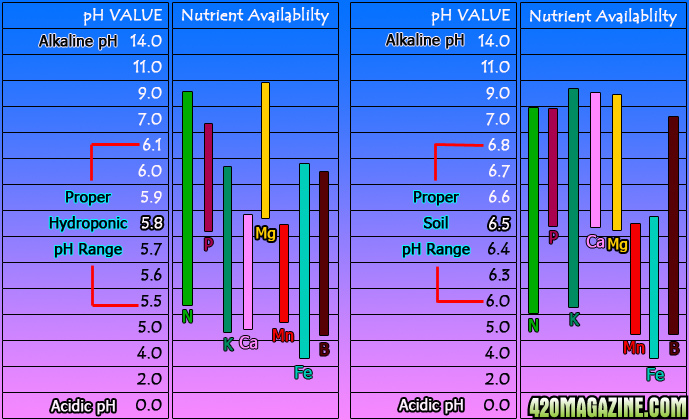
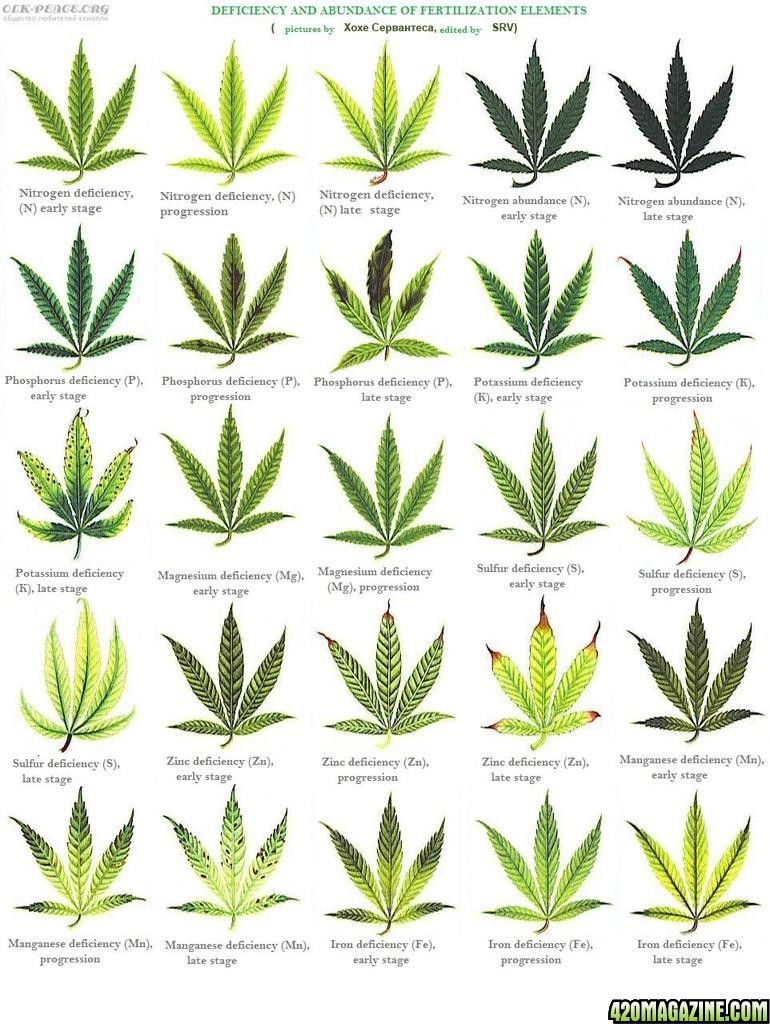
Magnesium (Mg) - Micronutrient and Mobile Element
Magnesium helps supports healthy veins while keeping a healthy leaf production and its structure. Magnesium is significant for chlorophyll-production and enzyme break downs. Magnesium which must be present in relatively large quantities for the plant to survive, but yet not to much to where it will cause the plant to show a toxicity.
Magnesium is one of the easiest deficiencies to tell... the green veins along with the yellowness of the entire surrounding leave is a dead giveaway, but sometimes that's not always the case here. In case you have one of those where it doesn't show the green veins, sometimes leaf tips and edges may discolour and curl upward. The growing tips can turn lime green when the deficiency progresses to the top of the plant. The edges will feel like dry and crispy and usually affects the lower leaves in younger plants, then will affect the middle to upper half when it gets older, but It can also happen on older leaves as well. The deficiency will start at the tip then will take over the entire outer left and right sides of the leaves. The inner part will be yellow and or brownish in colour, followed by leaves falling without withering. The tips can also twist and turn as well as curving upwards as if you curl your tongues.
Excessive levels of magnesium in your plants will exhibit a buildup of toxic salts that will kill the leaves and lock out other nutrients like Calcium (Ca). Mg can get locked out by having too much Calcium, Chlorine or ammonium in your soil/water.
One of the worst problems a person can have is a magnesium def caused by a ph lockout. By giving it more magnesium to cure the problem when you are thinking you are doing good, but actually you are doing more harm then good. When the plants can't take in a nutrient because of the ph being off for that element, the plant will not absorb it but it will be in the soil... therefore causing a buildup. A buildup will be noticed by the outer parts of the plant becoming whitish and or a yellowish color. The tips and part way in on the inner leaves will die and feel like glass. Parts affected by Magnesium deficiency are: space between the veins (Interveinal) of older leaves; may begin around interior perimeter of leaf.
Problems with Magnesium being locked out by PH troubles
Light Acid Soils, soils with excessive potassium, calcium and or phosphorus
Soil
Magnesium gets locked out of soil growing at ph levels of 2.0-6.4
Magnesium is absorbed best in soil at a ph level of 6.5-9.1 . (Wouldn't recommend having a ph of over 7.0 in soil) anything out of the ranges listed will contribute to a Magnesium deficiency.
Hydro and Soil less Mediums
Magnesium gets locked out of Hydro and Soil less Mediums at ph levels of 2.0-5.7
Magnesium is absorbed best in Hydro and Soil less Mediums at ph levels of 5.8-9.1
(Wouldn't recommend having a ph over 6.5 in hydro and soil less mediums.) Best range for hydro and soil less mediums is 5.0 to 6.0. Anything out of the ranges listed will contribute to a Magnesium deficiency.
Solution to fixing a Magnesium deficiency
Any Chemical/Organic nutrients that have Magnesium in them will fix a Magnesium deficiency. (Only mixing at ½ strength when using chemical nutrients or it will cause nutrient burn!)
Other nutrients that have magnesium in them are: Epsom salts, which is fast absorption. Dolomite lime and or garden lime (same thing just called different) which is slow absorption. Sulfate of Potash, Magnesia which is medium absorption. Worm Castings, which is slow absorption. Crabshell which is slow absorption. Earth Juice Mircoblast, which is fast acting. (a must buy!! Has lots of 2ndary nutrients).
Now if you added to much chemical nutrients and or organics,( which is hard to burn your plants when using organics) You need to Flush the soil with plain water. You need to use 2 times as much water as the size of the pot, for example: If you have a 5 gallon pot and need to flush it, you need to use 10 gallons of water to rinse out the soil good enough to get rid of excessive nutrients.
Picture one shows a mid grade magnesium deficiency.
(Picture 1 is Mine)
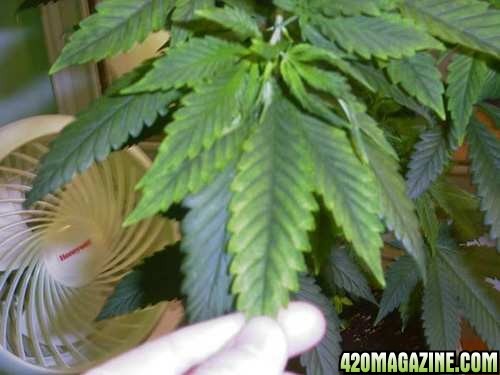
Calcium (Ca) -Macro Nutrient and an Immobile element.
Calcium is another important element that helps the plants cell walls, cell division in making the plants stems, stalks, branches stronger, as well as contributing to root growth, mostly the newer root hairs, Calcium also helps enhancing the uptake of K in the the plants roots. Calcium moves really slow within the plant and tends to concentrate in roots and older growth.
When plants exhibit a Calcium deficiency the younger leaves are the first to show it as well as older leaves. The Leaf tips will die back, the tips may curl, and growth of the plant is stunted. The plant can show a weakness in the stems and branches, as well as a under developed root system that can lead to bacteria problems with roots dieing off. Having slow plant transpiration rates can aggravate the uptake of calcium. Make sure your soil isn't very acidic, for calcium gets harder to be absorbed through acidic soils, Which leads to having a plant that is deficient in Calcium. The leaf tips, edges and new growth will or may turn a yellow/brown colour that happen in spots and often surrounded by a sharp brown outlined edge and then the leaf tips die back. If too much calcium is given at an early stage of growth it can stunt the growth of your plants. Having to much of calcium will also flocculate when a concentrated form is combined with potassium. The parts affected by a calcium deficiency are the roots. Stem or petiole, young or old leaves.
Too much Calcium will lead to other micronutrient deficiencies. Calcium fixation is caused by many types of mediums such as: clay soils, unbuffered coco and humus. The lime tends to bond to these soils very easily. The stems of the plant will not be able to hold the plant up and will exhibit a white brown in between the veins of the leaves when having too much calcium. Also having to much potassium and or nitrogen will cause a calcium lockout.
Problems with Calcium being locked out by PH troubles
Very acidic soils with excessive potassium, dry and or wet soil. Lack of calcium in the soil may cause too acidic soil. This may cause to Mg or Iron deficiency or very slow stunted growth
Soil
Calcium gets locked out of soil growing at ph levels of 2.0- 6.4
Calcium is absorbed best in soil at a ph level of 6.5-9.1 (Wouldn't recommend having a ph of over 7.0 in soil) anything out of the ranges listed will contribute to a
Calcium Deficiency.
Hydro and Soil less Mediums
Calcium gets locked out of Hydro and Soil less Mediums at ph levels of 2.0- 5.3
Calcium is absorbed best in Hydro and Soil less Mediums at ph levels of 5.4-5.8 (Wouldn't recommend having a ph over 6.5 in hydro and soil less mediums.) Best range for hydro and soil less mediums is 5.0 to 6.0. Anything out of the ranges listed will contribute to a Calcium Deficiency.
Solution to fixing a Calcium deficiency
To fix a calcium deficiency you can treat by foliar feeding with one teaspoon of dolomite lime or Garden lime per quart of water, Or Any Chemical/Organic nutrients that have Calcium in them will fix a Calcium deficiency. (Only mixing at ½ strength when using chemical nutrients or it will cause nutrient burn!)
Or you can take crushed up dolomite lime or garden lime in a gallon of water and water it in the soil. 1 to 2 teaspoons per gallon of water, which will be slow acting. Garden Gypsum, which is medium absorption. Limestone, which is medium absorption, Rock Phosphate and Animal wastes which are both medium/slow absorption. Note: Caution when using gypsum to an already acid soil (pH that is less than 5.5) can have a very bad effect on different types of plants by effecting the absorption of soil aluminum, which is poison to plant roots.
Now if you added to much chemical nutrients and or organics, (which is hard to burn your plants when using organics) you need to flush the soil with plain water. You need to use 2 times as much water as the size of the pot, for example: If you have a 5 gallon pot and need to flush it, you need to use 10 gallons of water to rinse out the soil good enough to get rid of excessive nutrients.
Pictures 1-2 shows calcium deficiencies. First one shows late, 2nd one shows early development.
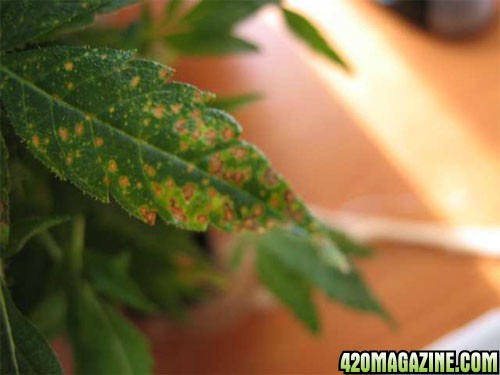

Magnesium (Mg)
Magnesium is a component of the chlorophyll molecule and serves as a cofactor in most enzymes.
Magnesium (Mg) deficiency:
Magnesium deficiency will exhibit a yellowing (which may turn brown) and interveinal chlorosis beginning in the older leaves. The older leaves will be the first to develop interveinal chlorosis. Starting at leaf margin or tip and progressing inward between the veins. Notice how the veins remain somewhat green though as can be seen in figure 15.
Notice how in figure 16 and 17 the leaves curl upwards like they're praying? They're praying for Mg! The tips may also twist.
This can be quickly resolved by watering with 1 tablespoon Epsom salts/gallon of water. Until you can correct nutrient lockout, try foliar feeding. That way the plants get all the nitrogen and Mg they need. The plants can be foliar feed at ½ teaspoon/quart of Epsom salts (first powdered and dissolved in some hot water). When mixing up soil, use 2 teaspoon dolomite lime per gallon of soil.
If the starting water is above 200 ppm, that is pretty hard water, that will lock out mg with all of the calcium in the water. Either add a 1/4 teaspoon per gallon of epsom salts or lime (both will effectively reduce the lockout or invest into a reverse osmosis water filter.
Mg can get locked-up by too much Ca, Cl or ammonium nitrogen. Don't overdo Mg or you'll lock up other nutrients.
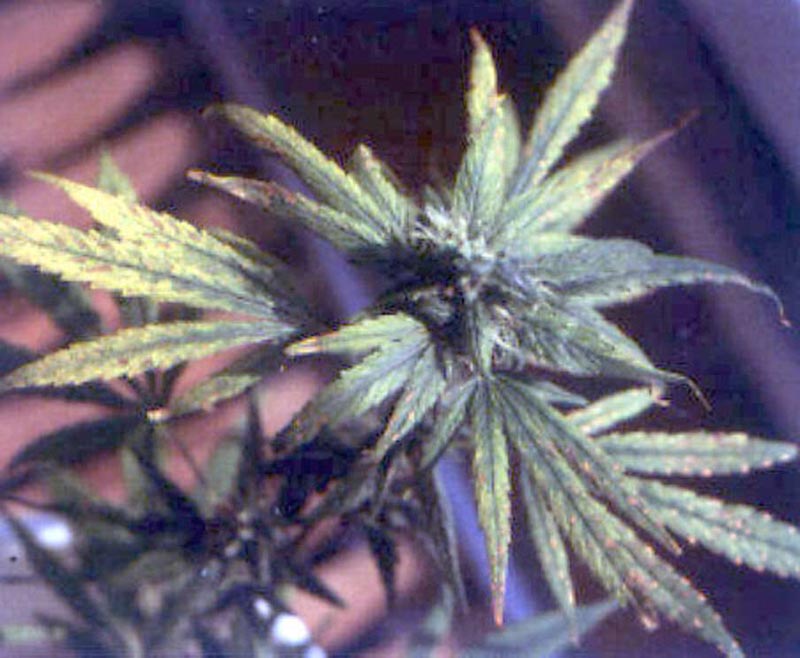
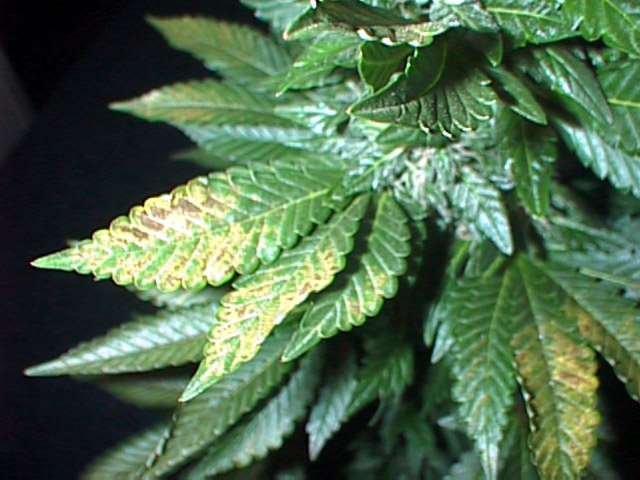
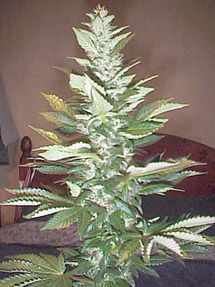
Magnesium (Mg) Toxicity:
Magnesium toxicity is rare and not generally exhibited visibly. Extreme high levels will antagonize other ions in the nutrient solution.
Calcium (Ca)
Calcium plays an important role in maintaining cell integrity and membrane permeability.
Calcium Deficiency:
Young leaves are affected first and become small and distorted or chlorotic with irregular margins, spotting or necrotic areas. Bud development is inhibited, blossom end rot and internal decay may also occur and root may be under developed or die back. Deficiency will cause leaf tip die-back, leaf tip curl and marginal necrosis and chlorosis primarily in younger leaves. Symptoms: young leaves develop chlorosis and distortion such as crinkling, dwarfing, developing a strap-like shape, shoots stop growing and thicken.
Calcium Toxicity:
Difficult to distinguish visually. May precipitate with sulfur in solution and cause clouding or residue in tank. Excess calcium may produce deficiencies in magnesium and potassium.





 Harley
Harley best of buds Dennise!
best of buds Dennise! 
 <3
<3